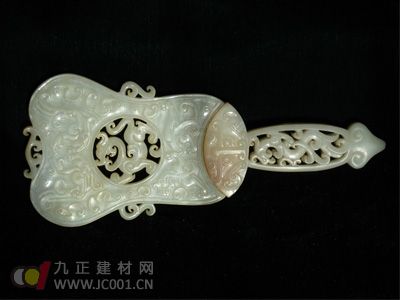Methods for Identifying Ancient Jade Artifacts:
Examining Fabric Fiber Marks: Many ancient jades were worn directly on the body or wrapped in fabric. Under specific temperature, humidity, and pressure conditions, fibers and pigments from the fabric can detach and stick to the jade’s surface. With a microscope, or even with the naked eye, you may observe colored fibers—red, blue, green, etc.—with clear patterns of weft and warp.
Insect Eggs and Debris: These are often found in the crevices of ancient jade artifacts, left behind by insects that lived near the burial sites over time.
Water Stains: In stable geological and atmospheric conditions, underground water flows continuously, seeping into the jade and creating various water stains. These can range from shallow to deep, forming unique patterns on the surface.
Plant Root Impressions: Some plant roots have a perforating characteristic. The acids produced by the decomposition of plant proteins can erode the surface of the jade, leaving root-like impressions with clear overlapping patterns.
Carbonization Marks: Ancient people practiced “cavity jade†rituals, where jade was burned and absorbed bio-carbon. This carbon appears as spots or layers, deeply embedded and difficult to remove. It often gives the jade a darkened or sooty appearance.

Examining Exorcism Mineral Residues: Certain natural minerals, such as hematite, cinnabar, and realgar, were believed to have purifying and protective properties. The ancients placed them in tombs and homes to ward off evil spirits. As a result, some ancient jades were wrapped or impregnated with these mineral powders. You can see small mineral particles on the surface or within the gaps. Over time, the coloring ions from these minerals can penetrate the jade, causing vivid color changes. For example, archaeological findings show that prehistoric humans scattered hematite powder in caves, and even dyed limestone beads red for aesthetic reasons. During the Warring States period and the Han Dynasty, many tombs contained cinnabar-dyed jades, like those found in the tomb of King Yue.
Checking Gaps and Filled Gravel: The surface of ancient jade often has silica and calcium carbonate minerals. These can appear as solid or liquid gravel, accumulating in the cracks, joints, and knots of the artifact. These deposits are tough and hard to remove, even if small stones entered through water.
Drill Marks: Since the invention of drilling tools, the drill bits were typically conical or diamond-shaped. Due to manual effort, the pressure was low, the speed slow, and the motion uneven. This results in drill marks that show a back-and-forth, parallel pattern with irregular swirls. Modern spiral drills, however, produce uniform, smooth holes without such patterns. In the Neolithic era, stone-drilling methods were similar to those used by ancient metal drillers.
In summary, identifying and evaluating ancient jade requires careful observation and comprehensive analysis. One must look at both microscopic details and the overall essence of the object, avoiding exaggeration or overlooking subtle clues. Only by systematically eliminating each possibility, reasoning, and combining intuition with logic, can one determine the authenticity of an ancient jade artifact with the highest accuracy.
3D Embossed Composite Fencing,Composite Slatted Fence,Synthetic Wood Fence,Composite Wood Slats For Gates
Jinhu Jusheng Plastic Wood New Material Co.,Ltd , https://www.goldenlakewpc.com
